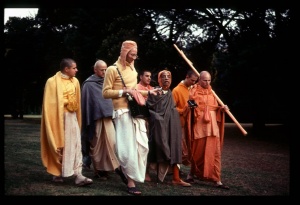CC Madhya 2.93 (1975): Difference between revisions
(Vanibot #0027: CCMirror - Mirror CC's 1996 edition to form a basis for 1975) |
(Vanibot #0020: VersionCompareLinker - added a link to the Version Compare feature) |
||
| Line 2: | Line 2: | ||
<div style="float:left">'''[[Sri Caitanya-caritamrta (1975)|Śrī Caitanya-caritāmṛta (1975)]] - [[CC Madhya (1975)|Madhya-līlā]] - [[CC Madhya 2 (1975)|Chapter 2: The Ecstatic Manifestations of Lord Śrī Caitanya Mahāprabhu]]'''</div> | <div style="float:left">'''[[Sri Caitanya-caritamrta (1975)|Śrī Caitanya-caritāmṛta (1975)]] - [[CC Madhya (1975)|Madhya-līlā]] - [[CC Madhya 2 (1975)|Chapter 2: The Ecstatic Manifestations of Lord Śrī Caitanya Mahāprabhu]]'''</div> | ||
<div style="float:right">[[File:Go-previous.png|link=CC Madhya 2.92 (1975)|Madhya-līlā 2.92]] '''[[CC Madhya 2.92 (1975)|Madhya-līlā 2.92]] - [[CC Madhya 2.94 (1975)|Madhya-līlā 2.94]]''' [[File:Go-next.png|link=CC Madhya 2.94 (1975)|Madhya-līlā 2.94]]</div> | <div style="float:right">[[File:Go-previous.png|link=CC Madhya 2.92 (1975)|Madhya-līlā 2.92]] '''[[CC Madhya 2.92 (1975)|Madhya-līlā 2.92]] - [[CC Madhya 2.94 (1975)|Madhya-līlā 2.94]]''' [[File:Go-next.png|link=CC Madhya 2.94 (1975)|Madhya-līlā 2.94]]</div> | ||
{{CompareVersions|CC|Madhya 2.93|CC 1975|CC 1996}} | |||
{{RandomImage}} | {{RandomImage}} | ||
==== TEXT 93 ==== | ==== TEXT 93 ==== | ||
<div class="verse"> | <div class="verse"> | ||
:choṭa baḍa bhakta-gaṇa, | :choṭa baḍa bhakta-gaṇa, vandoṅ sabāra śrī-caraṇa, | ||
:sabe more karaha santoṣa | :sabe more karaha santoṣa | ||
:svarūpa-gosāñira mata, | |||
:tāi | :svarūpa-gosāñira mata, rūpa-raghunātha jāne yata, | ||
:tāi likhi' nāhi mora doṣa | |||
</div> | </div> | ||
| Line 20: | Line 20: | ||
<div class="synonyms"> | <div class="synonyms"> | ||
choṭa—small; baḍa—great; bhakta-gaṇa—devotees; vandoṅ—I worship; sabāra—all of them; śrī-caraṇa—the lotus feet; sabe—all of you; more—unto me; karaha—please do; santoṣa—satisfaction; svarūpa-gosāñira mata—the view of Svarūpa Dāmodara Gosvāmī; rūpa-raghunātha—Rūpa and Raghunātha; jāne—know; yata—all; tāi—that; | choṭa—small; baḍa—great; bhakta-gaṇa—devotees; vandoṅ—I worship; sabāra—all of them; śrī-caraṇa—the lotus feet; sabe—all of you; more—unto me; karaha—please do; santoṣa—satisfaction; svarūpa-gosāñira mata—the view of Svarūpa Dāmodara Gosvāmī; rūpa-raghunātha—Rūpa and Raghunātha; jāne—know; yata—all; tāi—that; likhi'-writing; nāhi—there is not; mora—my; doṣa—fault. | ||
</div> | </div> | ||
| Line 34: | Line 34: | ||
<div class="purport"> | <div class="purport"> | ||
According to Śrīla Bhaktisiddhānta Sarasvatī Ṭhākura, there are three kinds of devotees, known as bhajana-vijña (experts in devotional service), bhajana-śīla (devotees engaged in devotional service), and kṛṣṇa-nāme dīkṣita kṛṣṇa-nāma-kārī (initiated devotees engaged in chanting). The author of Śrī Caitanya-caritāmṛta begs the mercy of all these devotees and asks them to be pleased with him. He says, | According to Śrīla Bhaktisiddhānta Sarasvatī Ṭhākura, there are three kinds of devotees, known as bhajana-vijña (experts in devotional service), bhajana-śīla (devotees engaged in devotional service), and kṛṣṇa-nāme dīkṣita kṛṣṇa-nāma-kārī (initiated devotees engaged in chanting). The author of Śrī Caitanya-caritāmṛta begs the mercy of all these devotees and asks them to be pleased with him. He says, "Let the neophyte devotees-the devotees who are very expert in arguing though they have no sense of advanced devotional service, who think themselves very advanced because they imitate some smārta-brāhmaṇa-let such devotees not be displeased with me, thinking that I have committed errors in this regard. I beg their pardon with great humility, but I am submitting that I personally have no desire to add or subtract anything. I have only written what I have heard in the disciplic succession because I am dedicated to the lotus feet of previous ācāryas like Svarūpa Dāmodara, Raghunātha dāsa Gosvāmī and Rūpa Gosvāmī. I have only written what I have learned from them." | ||
</div> | </div> | ||
Latest revision as of 12:34, 27 January 2020

A.C. Bhaktivedanta Swami Prabhupada
TEXT 93
- choṭa baḍa bhakta-gaṇa, vandoṅ sabāra śrī-caraṇa,
- sabe more karaha santoṣa
- svarūpa-gosāñira mata, rūpa-raghunātha jāne yata,
- tāi likhi' nāhi mora doṣa
SYNONYMS
choṭa—small; baḍa—great; bhakta-gaṇa—devotees; vandoṅ—I worship; sabāra—all of them; śrī-caraṇa—the lotus feet; sabe—all of you; more—unto me; karaha—please do; santoṣa—satisfaction; svarūpa-gosāñira mata—the view of Svarūpa Dāmodara Gosvāmī; rūpa-raghunātha—Rūpa and Raghunātha; jāne—know; yata—all; tāi—that; likhi'-writing; nāhi—there is not; mora—my; doṣa—fault.
TRANSLATION
I worship herewith the lotus feet of all kinds of devotees, both advanced and neophyte. I request all of them to be satisfied with me. I am faultless because I have written herein whatever I have understood from Svarūpa Dāmodara Gosvāmī and Rūpa and Raghunātha dāsa Gosvāmīs. I have neither added to nor subtracted from their version.
PURPORT
According to Śrīla Bhaktisiddhānta Sarasvatī Ṭhākura, there are three kinds of devotees, known as bhajana-vijña (experts in devotional service), bhajana-śīla (devotees engaged in devotional service), and kṛṣṇa-nāme dīkṣita kṛṣṇa-nāma-kārī (initiated devotees engaged in chanting). The author of Śrī Caitanya-caritāmṛta begs the mercy of all these devotees and asks them to be pleased with him. He says, "Let the neophyte devotees-the devotees who are very expert in arguing though they have no sense of advanced devotional service, who think themselves very advanced because they imitate some smārta-brāhmaṇa-let such devotees not be displeased with me, thinking that I have committed errors in this regard. I beg their pardon with great humility, but I am submitting that I personally have no desire to add or subtract anything. I have only written what I have heard in the disciplic succession because I am dedicated to the lotus feet of previous ācāryas like Svarūpa Dāmodara, Raghunātha dāsa Gosvāmī and Rūpa Gosvāmī. I have only written what I have learned from them."